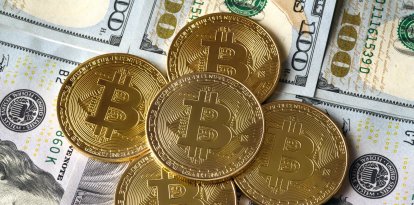China Is Winning the Economic Race with the US – The Consequences Will Be Profound
China's economic rise and the US response -- or lack of such -- will determine the predominant values of the 21st century.

Joe Biden and Xi Jinping (Nov 15, 2021) / Cordon Press.
China has closed the gap with the U.S. "in most economic races, even overtaking it in some," according to a recent report from Harvard's Belfer Center for Science and International Affairs. The report, "The Great Economic Rivalry: China Vs. the US," predicts that at the current rate, China will overtake the US economically within a decade.
Measured by purchasing power parity (PPP) -- which compares national economies in terms of how much each nation can buy with its own currency at the prices items sell for in its market -- China has already surpassed the US to become the world's largest economy.
"When measured by PPP, in 2000, China's economy was 36% the size of the United States," the report noted.
In 2020, the IMF found it was 115% the size of the U.S. economy, or one-seventh larger. While Presidents Obama, Trump, and now Biden have talked about a historic 'pivot' to Asia, the seesaw has shifted to the point that both of America's feet are dangling entirely off the ground.
When it comes to trade, China has now displaced the US, according to the report:
When this century began, China was knocking on the door of the WTO and the U.S. was the leading trading partner of most major economies. Today, China has overtaken the U.S. to become the largest trading partner for nearly every major nation... by 2018, 130 countries traded more with China than they did with the U.S., and more than two-thirds of those countries traded more than twice as much with China. With the launch of the Regional Comprehensive Economic Partnership (RCEP) in January, China has also now surpassed the U.S. as the leader of the world's largest free trade block.
The RCEP consists of China, Japan, South Korea, Australia, New Zealand, and the 10 members of ASEAN and is expected to add $500 billion to world trade by 2030.
China's trade policies are not a matter of simply creating more wealth for China, but as with most things that China does, a way to increase China's power and other countries' dependency on it: "As Xi Jinping explained last April, China's strategy in thickening trading relationships is not just to spur its own economic growth. It is to increase other nations' reliance on China," the Belfer center concluded. "China's goal – in Xi's words – is to tighten 'international production chains' dependence on China... Xi's strategy is working—not only with others but with the U.S. In 2021, purchases of products from China accounted for nearly half of America's $1 trillion trade deficit. Today, the U.S. is the world's largest debtor; China is the largest creditor."
When it comes to manufacturing, China already displaced the US a decade ago: "China has created a manufacturing ecosystem that allows it to dominate the production of almost everything," the report found. "Initially a low-cost producer of inexpensive consumer goods, China became the world's largest manufacturer in 2010 and accounted for 29% of global manufacturing value added in 2019 – a 20-point increase over 2000."
China accounts for one-third of global manufacturing today, while the US manufactures less than one-fifth. While the US was the primary trading partner for most countries in 2001, today China holds that position. As such, China has become the crucial link in the world's critical global supply chains: "Despite the rhetoric about decoupling, foreign economies have become more dependent on China during the coronavirus pandemic, not less," the report noted. "China's trade surplus with the world hit a record $675 billion in 2021, a 60% increase from pre-pandemic levels in 2019... China is now the world's largest manufacturer and exporter of scores of essential goods, including 90% of refined rare earth minerals, 80% of solar panels, 50% of computers, and 45% of electric vehicles."
China has even replaced the US as the driver of world economic growth.
Perhaps the most surprising fact for Americans who have not kept track of recent developments is that China has displaced the U.S. to become the primary engine of global growth. Since the Great Recession of 2008, approximately one-third of all growth in the world's GDP has occurred in just one country: China. Thus when nations around the world assess their prospective growth in the year ahead, the first economy they think about is China. In sum, in the past two decades, China has joined the U.S. and the EU as the third backbone of the global economy.
Furthermore, in 2020, for the first time, China, not the US, was home to the largest number of the most valuable global companies on Fortune's Global 500.
"For the first time since the magazine began listing its Global 500 rankings, China topped the list with 124 companies—ahead of the U.S.'s 121. Twenty years ago, this list included only ten Chinese companies," the Belfer report noted.
Crucially, China is severely challenging the US when it comes to innovation: "The U.S. and China have been neck and neck in R&D spending since 2017, together accounting for nearly half of global R&D expenditure," the Belfer center concluded. "Measured by PPP in 2010 dollars, between 2000 and 2019, U.S R&D expenditure almost doubled, growing from $360 billion to $610 billion. Chinese R&D investments, meanwhile, grew by a factor of 13, from $40 billion to $515 billion."
In 2013, the US was the number one top innovating country, according to the Bloomberg Innovation Index, but by 2020, it was not even in the top 10, having fallen to number 11. China still lagged behind at number 16, but, according to the report:
It is catching up. As our earlier report on the 'Great Tech Rivalry' noted, China's laser-like focus on frontier technologies has positioned it to dominate races like 5G and AI in the future. Moreover, in former Deputy Secretary of Defense Robert Work's apt summary, 'A lot of people still believe that all China does is steal technology and copy it. They still do that, and they're quite good at it. But also their technological ecosystem and their innovation ecosystem is really, really good. And it's getting better all the time.
While the report points out that China has not yet overtaken the US and that the dollar remains the world's dominant reserve currency, accounting for 60% of foreign exchange reserves, in addition to a few other areas, it seems increasingly difficult to see how the US could possibly turn things around with the current trajectory. Especially because China is determined to see this development to its goal of becoming the dominant power in the world by 2049.
What this means for global geopolitics is profound. At the end of World War II and for the decade that followed, the U.S. accounted for roughly half of global GDP. From this position of dominance, the U.S. took the lead in...what became the global economic order. When establishing alliances like NATO... the U.S. could cover the costs without thinking about burden-sharing. But by the end of the Cold War in 1991, America's share of global GDP had shrunk to one-fifth. Today it stands at one-sixth.... China's rise has created a new world economic order.
What this new world economic order means for the future is probably difficult to imagine for the many who have grown up with the US as the leading world power and the accompanying celebrated values of freedom, democracy, and capitalism, taken for granted by so many.
China's economic rise and the US response -- or lack of such -- will determine the predominant values of the 21st century – will it be China's authoritarianism and disregard for freedom, democracy, and human rights or those of the US and the West?

























